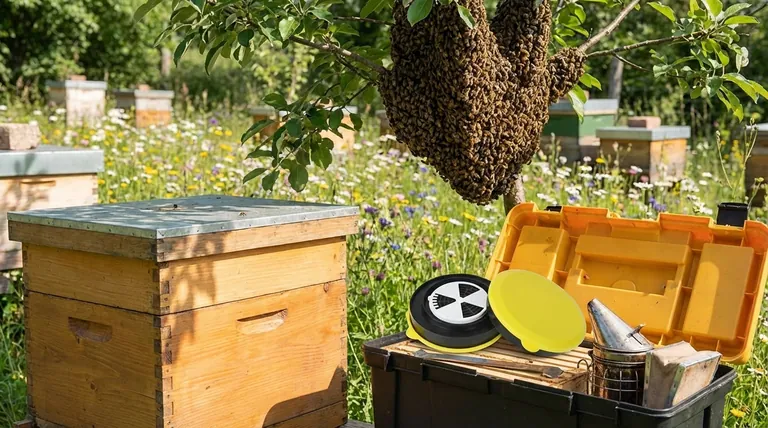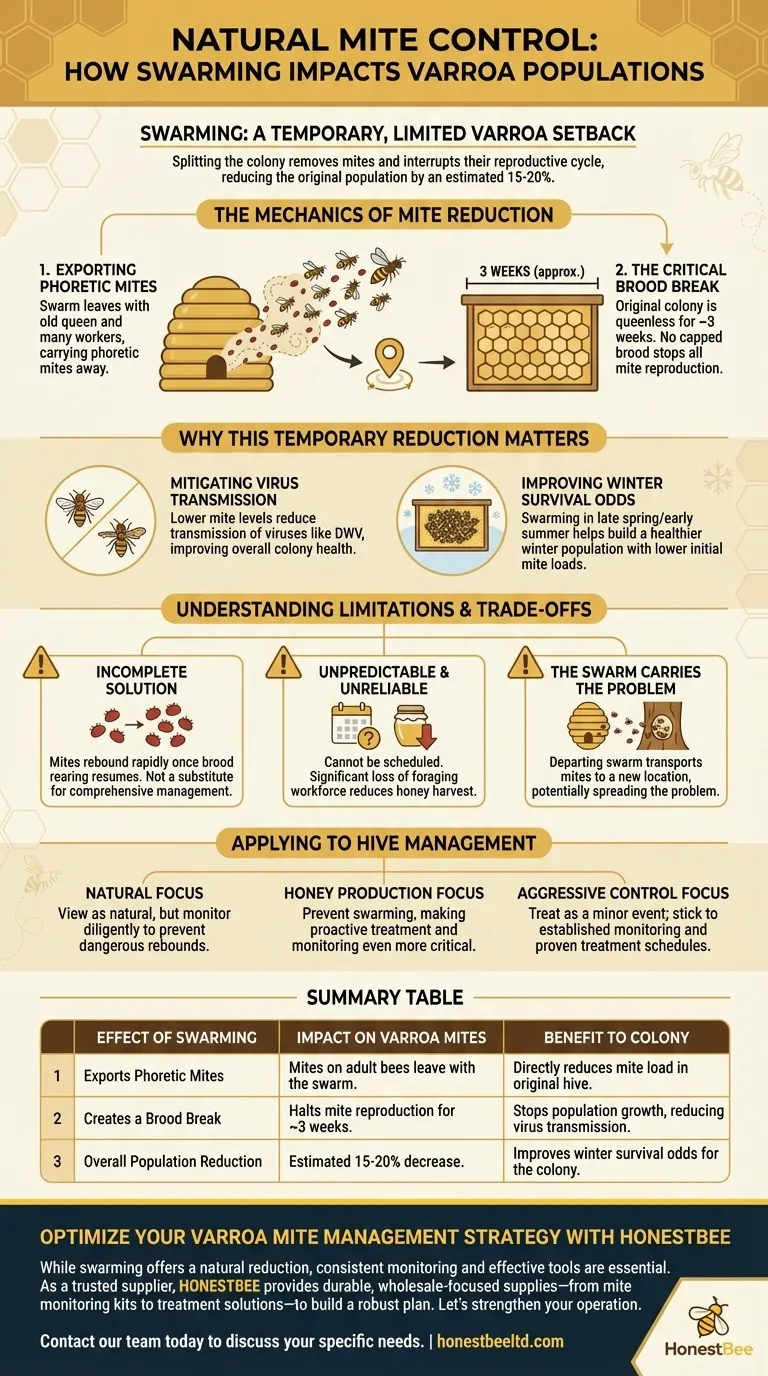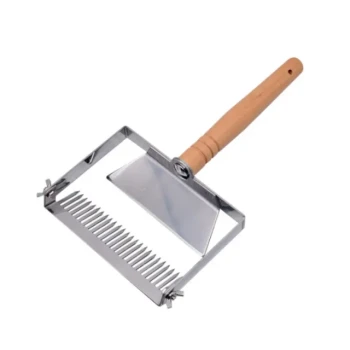In short, swarming acts as a natural, but limited, form of Varroa mite control. By splitting the colony, swarming physically removes a portion of the mites and, more importantly, creates a temporary break in the bee's brood cycle, which interrupts the mite's reproductive cycle. This process reduces the original colony's mite population by an estimated 15 to 20 percent.
While swarming provides a valuable, temporary setback to Varroa mite populations by reducing their numbers and breaking their reproductive cycle, it is not a sufficient substitute for a comprehensive mite management strategy.

The Mechanics of Mite Reduction During a Swarm
To understand the impact of swarming, we must look at how it disrupts the two key phases of the Varroa mite's life: the phoretic (on adult bees) and reproductive (in brood cells) stages.
Exporting Phoretic Mites
When a swarm leaves a hive, it is composed of the old queen and a large contingent of worker bees.
Varroa mites in their phoretic stage—those physically attached to adult bees—are carried away with these departing bees. This directly exports a percentage of the hive's total mite load to a new location.
The Critical Brood Break
After the primary swarm leaves, the original colony is left queenless for a period.
It takes time for a new virgin queen to emerge, mature, take her mating flights, and begin laying eggs. This creates a broodless period of about three weeks.
Since Varroa mites require capped brood cells to reproduce, this break in the brood cycle halts all mite reproduction within the original hive, temporarily stopping population growth.
Why This Temporary Reduction Matters
A 15-20% reduction and a three-week pause in reproduction may seem small, but they have significant implications for colony health, especially regarding viruses and seasonal survival.
Mitigating Virus Transmission
Varroa mites are the primary vector for transmitting devastating viruses, most notably the Deformed Wing Virus (DWV).
This virus cripples a honey bee's ability to fly, rendering it useless to the colony. By lowering the mite population, swarming can help reduce the transmission rate and overall virus load within the hive.
Improving Winter Survival Odds
Colonies entering winter with high Varroa levels are significantly more likely to perish.
Data shows that winter losses become more probable with mite levels as low as a natural drop of three mites per day in December. Swarming helps lower the mite count in late spring or early summer, giving the colony a better chance to build a healthy population of winter bees with a lower initial mite load.
Understanding the Limitations and Trade-offs
While beneficial, relying on swarming for mite control is a flawed strategy due to its inherent limitations and the goals of most beekeepers.
An Incomplete Solution
A 15-20% reduction is not enough to control a moderate to high mite infestation.
The remaining mite population can rebound very quickly once the new queen begins laying and brood becomes available again. Without further intervention, mite levels will likely reach damaging thresholds later in the season.
Unpredictability and Unreliability
Natural swarming is a biological impulse, not a predictable management tool.
A beekeeper cannot schedule a swarm to coincide with rising mite levels. Furthermore, from a production standpoint, swarming represents a significant loss of foraging workforce and, consequently, a reduced honey harvest.
The Swarm Carries the Problem
The swarm that leaves does not escape the mite problem; it simply carries it to a new home.
While this may benefit the original colony, it contributes to the spread of Varroa mites and associated viruses across the landscape, potentially impacting other managed or feral colonies.
How to Apply This to Your Hive Management
Your approach should depend on your specific beekeeping philosophy and goals.
- If your primary focus is natural beekeeping: View swarming as a positive, natural health mechanism for the colony, but follow up with diligent monitoring to ensure mite levels do not rebound to dangerous thresholds.
- If your primary focus is maximizing honey production: Implement swarm prevention techniques, but recognize that this removes a natural mite control event. This makes regular monitoring and proactive treatment even more critical to colony health.
- If your primary focus is aggressive Varroa control: Treat the mite reduction from a swarm as a helpful but minor event, and stick to your established schedule of monitoring and proven treatment methods to keep populations low.
Understanding the relationship between swarming and Varroa empowers you to make more informed decisions for the long-term health and success of your colonies.
Summary Table:
| Effect of Swarming | Impact on Varroa Mites | Benefit to Colony |
|---|---|---|
| Exports Phoretic Mites | Mites on adult bees leave with the swarm. | Directly reduces mite load in the original hive. |
| Creates a Brood Break | Halts mite reproduction for ~3 weeks. | Stops population growth, reducing virus transmission. |
| Overall Population Reduction | Estimated 15-20% decrease. | Improves winter survival odds for the colony. |
Optimize Your Varroa Mite Management Strategy with HONESTBEE
While swarming offers a natural reduction, consistent monitoring and effective tools are essential for long-term colony health. As a trusted supplier for commercial apiaries and beekeeping equipment distributors, HONESTBEE provides the durable, wholesale-focused supplies you need—from mite monitoring kits to treatment solutions—to build a robust, proactive management plan.
Let's strengthen your operation. Contact our team today to discuss your specific needs and explore our product catalog.
Visual Guide

Related Products
- Adjustable Formic and Acetic Acid Dispenser for Bee Mite Treatment
- Professional Bamboo Queen Isolation Cage
- Varroa Easy Check Mite Tester Kit Counter Alcohol Wash Jar
- Professional Galvanized Hive Strap with Secure Locking Buckle for Beekeeping
- Langstroth Screen Bottom Board for Beekeeping Wholesale
People Also Ask
- What should beekeepers do to manage varroa mites effectively? Adopt a Proactive Monitoring Strategy
- What are the symptoms of Varroa Mite Syndrome (VMS)? Recognizing the Signs of Colony Collapse
- What does Chewed Down Brood (CDB) indicate in bee colonies? A Sign of Varroa Mite Infestation
- What are phoretic mites? A Beekeeper's Guide to Monitoring Varroa Infestation
- What are some common predators and pests that target beehives? Protect Your Hives from Bears, Mites, and Beetles



















